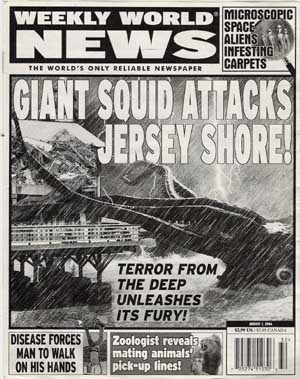
The Weekly
World News before it ceased publication was one of
the few newspapers still reporting hoax stories (Fair
Use).
|
Hoax Journalism
They scream at you from the magazine racks near
the checkout counter with improbable headlines like Aliens
Stole My Dog! Most people ignore them, or laugh at them.
As strange as it seems, however, these tabloids go back to long
standing-tradition in American culture involving authors as noteworthy
as Benjamin Franklin, Mark Twain and Edgar Allen Poe.
On August 27, 2007, one of the few remaining pillars
of a long-established American journalist tradition closed its
doors: The Weekly World News ceased paper publication.
Over the years the tabloid news magazine had featured such headlines
as:
Hillary
Clinton Adopts Alien Baby
Bat
Child Found in Cave
Mermaid
Caught in South Pacific.
The Weekly World News and its sister publication
The Sun often printed bizarre articles that either exaggerated
facts or were completely fabricated. Many people bought the publications
just for the humor within their pages. What most readers didn't
know was that such outrageously false news stories are hardly
a recent invention. The truth is that these newspapers are perhaps
the final holdout of a genre of fiction that has almost completely
vanished from the American scene: hoax journalism.
Hoax journalism has been around as long as there
have been newspapers, but perhaps it reached its zenith of popularity
in the 19th century. Many of these stories were not just exaggerations
of fact, or sloppy reporting. Some of the most well-known were
complete fabrications from beginning to end. Amazingly in this
era, newspapers from the smallest weekly publications to the biggest
daily city press printed hoaxes. Also, some of the most famous
names in American literature were behind the stories.
|
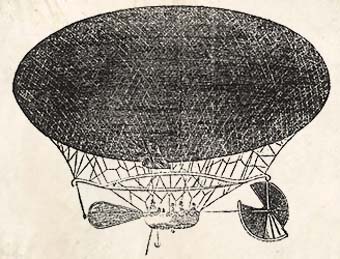
The
New York Sun included this illustration of the ballon
with Poe's article.
|
Mark Twain, the author of such classic American
books as The Adventures of Tom Sawyer and The
Adventures of Huckleberry Fin, started his career with
the fake story about an insane man in Carson City, Nevada, who
killed his wife and then went running through the streets of the
town "with his throat cut from ear to ear" while he carried his
wife's still warm scalp with him.
The
Great Balloon Hoax
Edgar Allen Poe, celebrated author of such stories
as The Tell-Tale Heart and The Masque of the Red Death,
wrote an article in 1844 which came to be known as The
Balloon Hoax. It was published in the New York Sun
and described the successful crossing of the Atlantic Ocean via
a balloon. In the article Poe described the construction of the
balloon (flown by a Mr. Monck, who was actually a well-know aviator
of that time) in perfect technical detail:
Like Sir George Cayley's balloon, his own was
an ellipsoid. Its length was thirteen feet six inches - height,
six feet eight inches. It contained about three hundred and twenty
cubic feet of gas, which, if pure hydrogen, would support twenty-one
pounds upon its first inflation, before the gas has time to deteriorate
or escape. The weight of the whole machine and apparatus was seventeen
pounds - leaving about four pounds to spare. Beneath the centre
of the balloon, was a frame of light wood, about nine feet long,
and rigged on to the balloon itself with a network in the customary
manner. From this framework was suspended a wicker basket or car.
|
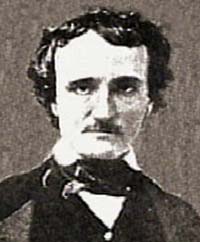
Edgar
Allen Poe wrote on of the most well-known hoaxes of the
19th century.
|
In truth, the actual crossing of the Atlantic by
a non-powered balloon wouldn't be accomplished for another hundred
years. Why did Poe participate in this fraudulent story? Though
he was recognized by some as an artist genius, Poe was low on
money. He had just moved his family to New York from Philadelphia
and had less than five dollars in his pocket. We he arrived he
aw a chance to cash in on an ongoing competition between the New
York Sun, Herald and Tribune newspapers. Each
wanted to be the first to break a sensational story and scoop
the other, even if it meant not bothering to check the facts.
Poe sold the story, then stood back and watched the excitement
it created. Later he wrote:
On the morning of its announcement, the whole
square surrounding the 'Sun' building was literally besieged,
blocked up-ingress and egress being alike impossible, from a period
soon after sunrise until about two o'clock P.M.... I never witnessed
more intense excitement to get possession of a newspaper. As soon
as the few first copies made their way into the streets, they
were bought up, at almost any price, from the news-boys, who made
a profitable speculation beyond doubt. I saw a half-dollar given,
in one instance, for a single paper, and a shilling was a frequent
price. I tried, in vain, during the whole day, to get possession
of a copy.
When the story could not be confirmed, the Sun was
forced to retract the article the next day, but not before it
had sold a lot of newspapers.
|
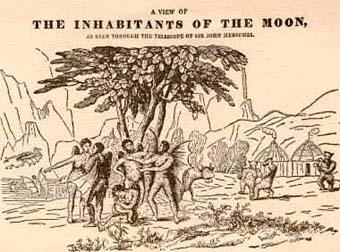
Illustrations
from the 1835 article offered to show readers what life
was like on the moon.
|
The
Great Moon Hoax
Perhaps the most famous journalistic hoax of the
era occurred a few years earlier in late August of 1835. The New
York Sun ran a series of articles supposedly reprinted from
the fictitious Edinburgh Journal of Science. In these an
Andrew Grant reported that Sir John Herschel, using a new, powerful
telescope, had discovered life on the moon. The articles described
a lunar landscape that included beaches, jungles and oceans and
was populated by bison, blue unicorns and tail-less, bipedal,
intelligent beavers. Perhaps the most startling discovery, according
to stories, was the existence of furry, winged, "moon men:"
Certainly they were like human beings, for their
wings had now disappeared and their attitude in walking was both
erect and dignified. They averaged four feet in height, were covered,
except on the face with short and glossy copper-colored hair,
and had wings composed of a thin membrane, without hair...
While Herschel was a well-known astronomer at the
time, there was no Andrew Grant and the actual author is believed
to be a Sun reporter named Richard Adams Locke. While this
series of articles seems outrageous today, many people at the
time took it at face value. One witness remembered how the students
and professors at Yale college "looked daily for the arrival
of the New York mail with unexampled avidity and implicit faith.
Have you seen the accounts of Sir John Herschel's wonderful discoveries?
Have you read the Sun? Have you heard the news of the man
in the Moon? These were the questions that met you every where.
It was the absorbing topic of the day. Nobody expressed or entertained
a doubt as to the truth of the story."
Despite this account, some competing newspapers
and sources at the time were skeptical about the series, expressing
doubt that the building of a new, fantastically-powerful telescope
- which would have taken years - would have gone without notice
in the English press. Interestingly enough, unlike other hoaxes,
the Sun never acknowledged the series was fiction, though
in its September 16th, 1835, edition, it did run a column discussing
such a possibility.
|
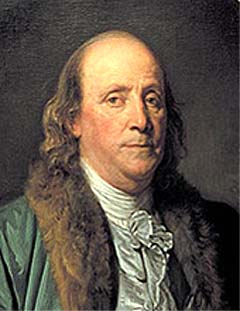
Ben
Franklin is thought to be the author of the Witch Trial
Hoax of 1730.
|
Witch
Trials in New Jersey
While profit and entertainment was often the reason
for such an article, sometimes a hoax story was also written to
make a political or social point. On October 22, 1730, The
Pennsylvania Gazette printed an article entitled A
Witch Trial at Mount Holly. The story, whose author is
thought to be Benjamin Franklin (who published the Gazette),
contains a description of a very unlikely witch trial in southern
New Jersey:
…the Accused had been charged with making their
Neighbours Sheep dance in an uncommon Manner, and with causing
Hogs to speak, and sing Psalms, &c. to the great Terror and Amazement
of the King's good and peaceable Subjects.
The authorities decided to try the witches (along
with two non-witches for comparison) by seeing if they weighed
less than a thick copy of the bible, or if they would float in
water - both thought to be ancients signs of a witch. When neither
test gave the inquisitors a reliable result, and believing that
the female accused's clothes might have helped her float, the
court decided to recess and try the water test again, later.
…they are to be tried again the next warm Weather,
naked.
Why did Franklin write this story? Probably he was
making a statement about the silliness of such beliefs. The Salem
witch trials had occurred just thirty-eight years before,
leading to the death of twenty-five people. The beliefs that led
to the trials were still prevalent in Franklin's day, and Franklin,
a man of science, wanted to expose such things as ludicrous.
Newspapers
More Than Just News
While some of these stories, like Franklin's, were
written to make people think, most were created to just amuse
the readership. The appearance of hoax stories in newspapers really
isn't that surprising if one recalls that much of the conventional
fiction of the day, which we now associate with books, was originally
published in the form of newspaper serials. Newspapers of the
era saw their role as entertaining the public as much as informing
it.
While the colorful tradition of hoax journalism
gives us an insight into entertainment in previous centuries,
it occasionally causes historians problems. Any strange tale found
in newspapers of the period must be considered suspect unless
it can be confirmed with other sources such as letters, other
publications, or physical evidence.
As the 19th century was left behind and the 20th
century dawned the public began to demand more accuracy from their
newspapers. Most dropped their hoax stories and many required
independent fact checking on important articles. A few tabloid
publications continued the hoax tradition, but with the demise
of The Weekly World News there is now one less. Still,
the Sun continues to be sold at newsstands and The Weekly
World News is available in a web edition, so just remember
when you see a headline like UFO CAPTURES LOCH NESS
MONSTER! that you're looking at the last of a long-standing
tradition.

Copyright Lee
Krystek 1996-2008. All Rights Reserved.